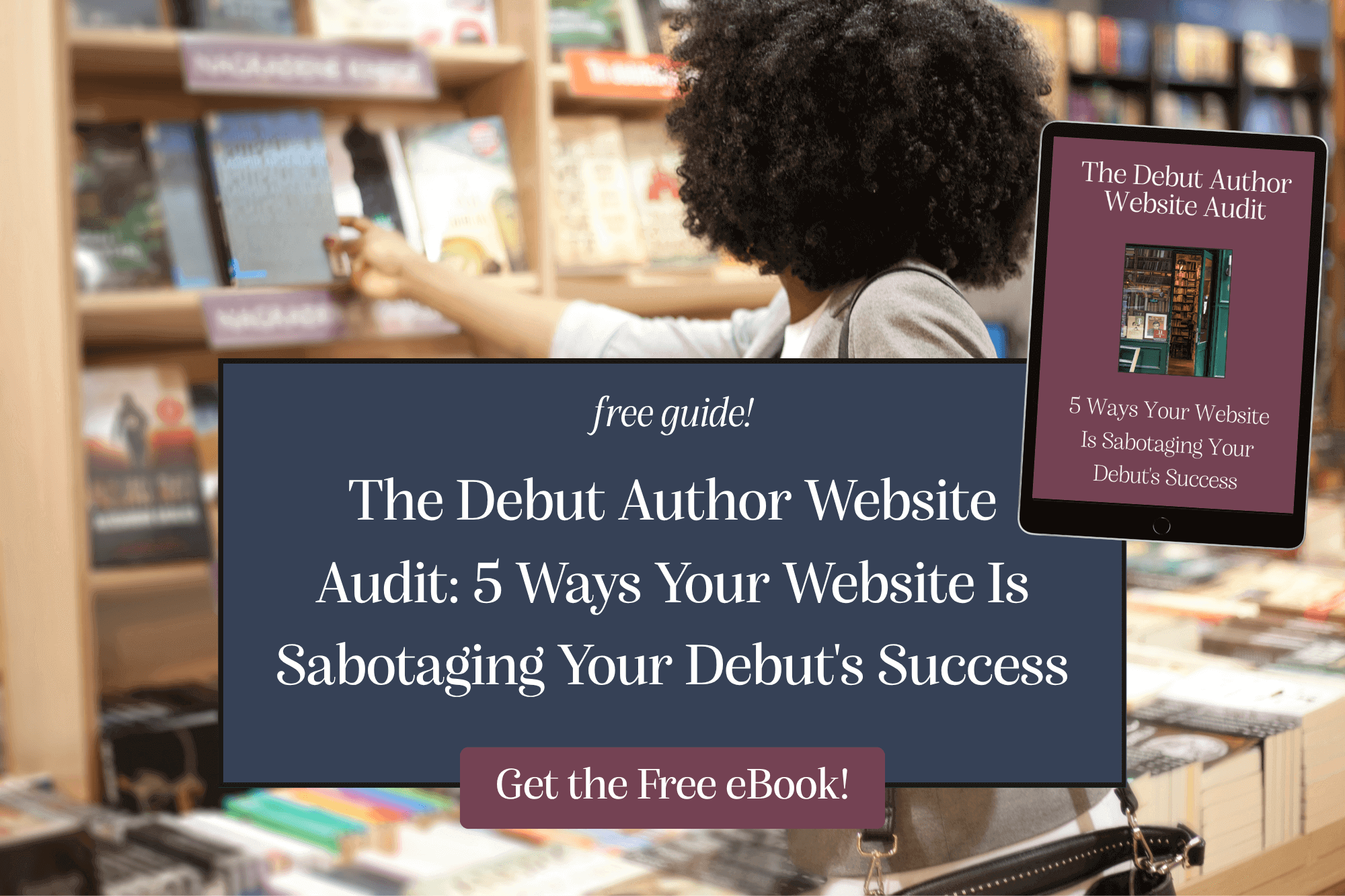Why Every Author Needs an Email List (And How Your Website Can Build It)
The Truth About Email Lists
The bottom line: If you're serious about your writing career, you need an email list. Period.
While other authors chase social media followers and pray their posts get seen, smart authors are building direct lines to their readers through email marketing.
The results?
Book sales that don't depend on algorithm changes, loyal readers who actually buy their work, and sustainable author careers that grow with every release.
The Cold, Hard Truth About Author Marketing
Here's what no one tells debut authors: marketing is the hardest part of being a writer.
A recent survey found that 78.5% of indie authors cite marketing as their biggest challenge.
Not writing. Not editing.
Marketing.
But here's the twist that successful authors understand: email marketing isn't just marketing—it's relationship building.
Why Email Lists Beat Every Other Marketing Channel
Email Delivers Real Results for Authors
The numbers don't lie. Email marketing generates between $36 and $42 for every dollar spent, delivering an ROI of up to 4,200%.
For authors specifically, the statistics are even more encouraging.
Industries described as "fiction" or "writing" had email open rates of 42% or higher compared to the industry average of around 32%.
Translation: When you email your readers about your new book, nearly half of them will actually open and read your message.
You Own Your Audience (Finally!)
Social media platforms come and go. Algorithm changes can destroy your reach overnight.
But your email list? That's yours forever.
4.37 billion people use email globally, and that number is growing to an estimated 4.89 billion by 2027. Meanwhile, social media platforms are becoming increasingly pay-to-play.
The reality: Email is the only marketing channel where you truly own your audience relationship.
Email Users Are Serious Buyers
Here's the statistic that should make every author pay attention: Email marketing persuades the purchasing decisions of nearly 6 out of every 10 email subscribers.
Even better? 50.7% of people buy something from a marketing email at least once per month, while 23.8% make purchases several times per month.
For authors, this means: When you announce a new book to your email list, a significant percentage will actually buy it—often within hours of your announcement.
What High-Earning Authors Know About Email Lists
Volume Matters (But Not How You Think)
Authors earning $25,000+ per month had income across an average of 61 titles, while those earning $1,000-$2,500 per month had an average of 30 titles.
But here's the key insight: these successful authors aren't starting over with marketing for each book. They're leveraging their email lists to turn every new release into immediate sales.
The compound effect: Each book you publish grows your email list, which makes your next book launch more successful, which grows your list further.
Direct Connection Beats Social Media Noise
85% of surveyed authors have newsletters, and they're seeing results that social media simply can't match.
As one author explained: "I have a newsletter to build a rapport with readers on my own terms where I own the data myself, as well as inform them about the things they want to know the most. Books."
The difference: Social media is public performance. Email is a private conversation that builds a more intimate relationship with readers.
How Your Website Becomes an Email List Building Machine
Your Website Is Your 24/7 List Builder
Think of your website as a digital street team that never sleeps.
While you're writing your next bestseller, your website should be working around the clock to turn curious visitors into devoted email subscribers.
But most author websites fail at this crucial job. They're beautiful portfolios that don't actually do anything.
The fix: Every page of your website should have one clear purpose—getting visitors to join your email list.
The Author Website Conversion Formula
Successful author websites follow a simple formula:
Compelling Reason to Subscribe + Valuable Free Offer + Strategic Placement = Growing Email List
48% of consumers happily give their email address to receive a discount—but authors have something even better than discounts. You have exclusive content.
Examples of what works:
Free short stories or bonus chapters
Early access to cover reveals and book announcements
Behind-the-scenes writing process content
Character guides and world-building extras
Writing tips and author interviews
Where Email Capture Happens on Your Site
Your website has multiple opportunities to capture emails, but placement is everything:
Header CTA Button: Your most important call-to-action should live in your website header—visible on every page.
Pop-ups: Despite mixed feelings about pop-ups, they statistically work for email capture when implemented thoughtfully.
Footer Sign-ups: Less intrusive but consistently visible as readers scroll.
Dedicated Landing Pages: Custom pages with no distractions, focused solely on email capture.
Book Pages: Every book page should offer related bonus content in exchange for emails.
Ready to add a call to action to your author website? Read the companion blog, “The Author Website CTA That Actually Converts (Hint: It’s Not “Subscribe”) and learn how to best create your own call to action. (Coming Soon!)
The Author Email List Growth Strategy
Start With Your Existing Audience
The most common tactics for growing email lists are sharing links in the back matter of books or on social media.
Book back matter is your secret weapon. Readers who finish your book are your most engaged audience—they're primed to want more from you.
The back matter formula:
Thank the reader for their time
Offer exclusive bonus content related to the book
Provide a simple link to sign up
Tease what subscribers get (free stories, early access, etc.)
Leverage Every Reader Interaction
Every time you connect with readers, you have an email list-building opportunity:
Book signings: Provide a simple QR code for newsletter sign-up
Podcast appearances: Mention your free reader magnet
Social media: Regularly (but not constantly) promote your list
Author collaborations: Cross-promote with other authors in your genre
Content That Converts Browsers to Subscribers
The mistake most authors make: They ask people to "subscribe to my newsletter" without explaining what's in it for the reader.
The solution: Lead magnets that provide immediate value.
High-converting lead magnets for authors:
Prequel stories that expand your fictional world
Character interviews that reveal hidden backstories
Writing process videos showing how you craft scenes
Reading guides for book clubs interested in your work
Deleted scenes that didn't make the final cut
Email Marketing Automation for Authors
Set It and Forget It Systems
Automated emails drove 37% of all email-generated sales, despite accounting for just 2% of email volume.
Translation: Set up your email automation once, and it works for you forever.
Essential automated sequences every author needs:
Welcome Series: Introduce new subscribers to you and your work over 3-5 emails.
New Release Announcements: Automatically notify your list when you publish.
Reader Magnet Delivery: Instantly send promised free content to new subscribers.
Re-engagement Campaigns: Win back subscribers who haven't opened emails recently.
The Author Welcome Sequence That Works
Your welcome sequence is your first impression with new subscribers. Make it count.
Email 1 (Send immediately): Deliver the promised free content and set expectations.
Email 2 (Send 3 days later): Share your author story and what drives your writing.
Email 3 (Send 1 week later): Recommend where new readers should start with your books.
Email 4 (Send 2 weeks later): Behind-the-scenes content about your writing process.
Email 5 (Send 1 month later): Exclusive content or early access to something special.
Measuring Your Email List Success
Metrics That Actually Matter for Authors
Open rates tell you if your subject lines work.
Click rates show if your content engages readers.
Conversion rates reveal if subscribers become buyers.
But the most important metric for authors? List growth rate.
79% of authors have 5,000 subscribers or fewer, but those numbers are growing. The authors who started building lists early have the advantage.
Industry Benchmarks for Author Emails
Good author email performance:
Open rates: 35-45% (authors consistently outperform other industries)
Click rates: 2-5%
List growth: 10-15% monthly growth for active authors
Unsubscribe rates: <0.5% per email
Authors topped the chart for unsubscribe rates at 0.21%, but this is still incredibly low, showing that readers genuinely want to hear from authors they love.
Common Author Email List Mistakes (And How to Avoid Them)
Mistake #1: Waiting Until Your Book Is Published
The problem: Authors think they need a published book before starting an email list.
The reality: Successful authors build their lists while writing. Readers love following the journey of book creation.
The fix: Start collecting emails as soon as you begin your author website. Share your writing progress, research insights, and creative process.
Mistake #2: Making It All About You
The problem: Newsletters that read like author diaries—"Here's what I did this week."
The reality: The best approach focuses on providing the reader with what the reader wants to know or learn, not what you want to tell them.
The fix: Every email should provide value to your readers—entertainment, insights, exclusive content, or early access to something they care about.
Mistake #3: Inconsistent Communication
The problem: Emailing only when you have a book to sell.
The reality: 99% of users claim to check their email inbox every day, but they unsubscribe from lists that only contact them for sales pitches.
The fix: Regular, valuable communication builds relationships. Consistent authors see better results than frequent sellers.
Your Website's Role in Email List Building
The Author Website Audit Question
Ask yourself this: If someone lands on my website right now, would they want to join my email list?
If the answer isn't an immediate "yes," your website needs work.
Your website should answer:
Who are you as an author?
What do you write?
Why should readers care?
What do they get for subscribing?
How do they sign up?
CTA Strategy for Author Websites
Your call-to-action (CTA) strategy determines whether visitors become subscribers.
The header CTA should be your most important action—for most authors, that's email list sign-up, not book sales.
Why? One email subscriber can become a buyer of multiple books over time. One book sale is just one transaction.
Strategic CTA placement:
Header: Newsletter sign-up
Book pages: Related bonus content
About page: Welcome to the community
Blog posts: Topic-specific lead magnets
Contact page: Stay in touch option
The Long-Term Author Career Strategy
Email Lists Build Author Careers
42.7% of authors say their primary motivation for writing is 'to make money,' and authors who specifically state that their goal was to make money from their writing tend to be higher earners.
The connection: Authors who treat writing like a business—including building email lists—see better financial results.
Your email list becomes:
A guaranteed audience for every book launch
Market research about what readers want next
A direct sales channel that doesn't depend on retailers or algorithms
A community that promotes your work through word-of-mouth
The Compounding Effect of Author Email Lists
Every email subscriber represents multiple future book sales. Every new book you publish grows your list, which improves your next launch, which attracts more subscribers.
The math: If you have 1,000 email subscribers and 10% buy your new book, that's 100 immediate sales. If each book also gains you 50 new email subscribers, your next launch could generate 105 sales, then 110, then 115...
This is why successful authors never stop building their lists.
Ready to Build Your Author Email List?
The bottom line: Email marketing isn't optional for serious authors—it's essential.
While you can't control algorithm changes, book review policies, or retail placement, you CAN control your direct relationship with readers.
Your next steps:
Audit your website for email capture opportunities
Create a valuable lead magnet that your ideal readers would want
Set up your welcome sequence to nurture new subscribers
Start collecting emails from every reader interaction
Commit to consistent, valuable communication
The authors building email lists today are creating the sustainable careers of tomorrow. The question isn't whether you need an email list—it's whether you're ready to start building one.












